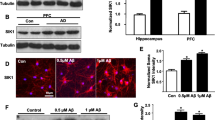Abstract
PROGRESSIVE cerebral deposition of the 39–43-amino-acid amy-loid β-protein (Aβ) is an invariant feature of Alzheimer's disease which precedes symptoms of dementia by years or decades. The only specific molecular defects that cause Alzheimer's disease which have been identified so far are missense mutations in the gene encoding the β-amyloid precursor protein (β3-APP) in certain families with an autosomal dominant form of the disease (familial Alzheimer's disease, or FAD)1–5. These mutations are located within or immediately flanking the Aβ region of β-APP, but the mechanism by which they cause the pathological phenotype of early and accelerated Aβ deposition is unknown. Here we report that cultured cells which express a β-APP complementary DNA bearing a double mutation (Lys to Asn at residue 595 plus Met to Leu at position 596) found in a Swedish FAD family5 produce ∼6–8-fold more Aβ than cells expressing normal β-APP. The Met 596 to Leu mutation is principally responsible for the increase. These data establish a direct link between a FAD genotype and the clinicopathological phenotype. Further, they confirm the relev-ance of the continuous Aβ production by cultured cells6–8 for elucidating the fundamental mechanism of Alzheimer's disease.
Similar content being viewed by others
References
Goate, A. et al. Nature 349, 704–706 (1991).
Chartier Harlin, M. D. et al. Nature 353, 844–846 (1991).
Murrell, J., Farlow, M. Ghetti, B. & Benson, M. D. Science 254, 97–99 (1991).
Hendriks, L. et al. Nature Genet. 1, 218–221 (1992).
Mullan, M. et al. Nature Genet. 1, 345–347 (1992).
Haass, C. et al. Nature 359, 322–325 (1992).
Seubert, P. et al. Nature 359, 325–327 (1992).
Shoji, M. et al. Science 258, 126–129 (1992).
Kang, J. et al. Nature 325, 733–736 (1987).
Selkoe, D. J. et al. Proc. natn. Acad. Sci. U.S.A. 85, 7341–7345 (1988).
Weidemann, A. et al. Cell 57, 115–126 (1989).
Oltersdorf, T. et al. J. biol. Chem. 265, 4492–4497 (1990).
Esch, F. S. et al. Science 248, 1122–1124 (1990).
Sisodia, S. S., Koo, E. H., Beyreuther, K., Unterbeck, A. & Price, D. L. Science 248, 492–495 (1990).
Chen, W. J., Goldstein, J. S. & Brown, M. S. J. biol. Chem. 265, 3116–3123 (1990).
Haass, C., Koo, E. H., Mellon, A., Hung, A. Y. & Selkoe, D. J. Nature 357, 500–503 (1992).
Haass, C., Hung, A. Y., Schlossmacher, M. G. & Selkoe, D. J. J. biol. Chem. (in the press).
Seubert, P. et al. Nature (in the press).
Levy, E. et al. Science 248, 1124–1126 (1990).
Author information
Authors and Affiliations
Rights and permissions
About this article
Cite this article
Citron, M., Oltersdorf, T., Haass, C. et al. Mutation of the β-amyloid precursor protein in familial Alzheimer's disease increases β-protein production. Nature 360, 672–674 (1992). https://doi.org/10.1038/360672a0
Received:
Accepted:
Issue Date:
DOI: https://doi.org/10.1038/360672a0
- Springer Nature Limited
This article is cited by
-
Reply to Johansson ‘Treatment with BRICHOS domain helps to clarify issues with Alzheimer mouse models’
EMBO Molecular Medicine (2024)
-
Differential effects of familial Alzheimer’s disease-causing mutations on amyloid precursor protein (APP) trafficking, proteolytic conversion, and synaptogenic activity
Acta Neuropathologica Communications (2023)
-
ADAMTS4 is involved in the production of the Alzheimer disease amyloid biomarker APP669-711
Molecular Psychiatry (2023)
-
Antibody binding of amyloid beta peptide epimers/isomers and ramifications for immunotherapies and drug development
Scientific Reports (2023)
-
Alzheimer’s disease – the journey of a healthy brain into organ failure
Molecular Neurodegeneration (2022)





